Drought tolerant grasses.
Arundo donax Giant Reed Grass. A large blue cornstalk-like accent plant. Wonderful near ponds or water, but will tolerate dry sites once established. I often combine this plant with Joe-Pyeweed or with deep red violet perennial lobelia. (Can be invasive where happy!) The Variegated form, has a beautiful cream variegation coming in wide stripes.
A great accent plant in any landscape. Here is a picture of one of the plants I associated it with. CARDOON
Calamagrostis acutiflora ‘Karl Foerster’
Festuca glauca and amethystina – Blue Fescue
Helictotrichon sempervirens Blue Oat Grass – (Avena was it’s more common name) Much more civilized than the plant to the right. A welcome addition to the garden. This wonderful blue mound is long lived and undemanding. Mass plantings are suggested as you will inherit a blue meadow. Full sun, and winter raking is needed to remove old foliage.
Koeleria glauca: (Coolaria) 🙂 Blue Hair grass is an ideal border plant, non-invasive and attractive as an accent or along an edge. In hot dry conditions, ample water and light shade bring out the best in this grass, but it will tolerate the exposed condition of a rock garden. This grass prefers lean soil and will not look its best when grown in rich soil.
Elymus arenarius glaucus ‘Blue Dune‘: This is a very blue selection of (Blue lyme Grass) and will grow some 3-4 ft. high. It is a seashore dune grass and will spread rapidly in loose soil. It is ideal for seashore erosion control and for water filtration projects near the ocean. It can also be used as an ornamental in pots or in contained areas such as parking lot islands.
Deer Resistant Grasses
Brizia media: A delightful grass with a low to medium habit. Short clumps of deep-green leaves bear upright stems of delicate heart-shaped greenish-purple spikes in late spring and early summer
Miscanthus species & cultivars From ‘Sarabunde,’ ‘Morning Light,’ dwarf and variegated forms to the giant Miscanthus floridulus you cannot ask for more diversity. Some have great fall color and all are very hardy.
Elymus arenarius glaucus 'Blue Dune': This is a very blue selection of (Blue lyme Grass) and will grow some 3-4 ft. high. It is a seashore dune grass and will spread rapidly in loose soil. It is ideal for seashore erosion control and for water filtration projects near the ocean. It can also be used as an ornamental in pots or in contained areas such as parking lot islands.
Helictotrichon sempervirens: (Blue Oat Grass) A 2-3 ft. drought and heat tolerant grass. Semi-evergreen with a silver-blue spiky foliage. Flower/seed stems can reach 4' ft. in spring.
Panicum virgatum & cultivars (Red Switch Grass, 5 ft., sun. Cascading gray-green foliage has clouds of tiny, dark red blowers that dance in the wind. A showy grass with yellow-gold fall color.
Phalaris arundinacea Picta (variegata): Ribbon Grass- Variegated white foliage. Good plant near the water, but can take drought as well. A good nesting grass for wildlife and a good soil stabilizer -- read can be invasive! Or considered a noxious weed. This picture is for the standard and more aggressive form.
Schizachyrium scoparium - Bluestem - Blue foliage forms small one foot clumps, topped by willowy plumes to 3 feet tall in late summer. Reddish-burgundy fall color. Good heat and humidity tolerance! Also deer resistant as are most of these grasses!
Stipa tenuissima An indispensable grass that contributes flowing grace and feminine lines to every garden. Hair like green blades are topped by airy golden-cream inflorescence's that can stick to your clothes!
Sorghastrum nutans - commonly known as Yellow Indian grass. One of the major constituents of the Midwest Tall Grass Prairie. Indian Grass creates tall seas of waving amber hues. Native grasses such as this are also important as a food source for grazing livestock, as it is hardy and can live through flooding and repeated fires.
Sporobolus heterolepsis: Commonly known as Prairie dropseed, is a species of prairie grass native to the tallgrass and mixed grass prairies of central North America.
Coastal Plantings - Grasses that can tolerate salt and wind.
Arundo donax and cultivars: Towering stalks with broad blue green leaves. Large clumps rustle in the wind and make dramatic specimen plants or an exotic screen. Can take sea exposure.
Chasmanthium latifolium: Northern Sea Oats or (Indian Forest Oats). Grows to 3' ft. high and looks like a bluish bamboo. Forms non-invasive clumps of great beauty in light shade. Attractive oat-like seeds appear in late summer becoming colorful in fall. Highly recommended for seashore plantings.
Cortaderia selloana & cultivars: Silver blooming Pampas Grass that will grow 6 - 8 ft. high. The lush gray-gray green foliage is topped with billowy silvery-white blooms. Can freeze back in a hard winter. Zones 7-10. Cleaning up such damage can be 'bloody' work as the leaves are sharp.
A few thoughts on Grass Maintenance!
Are Grasses easy to maintain?. It may be a matter of interpretation. Pests and diseases -- Low maintenance -- YES.
Cutting back and disposing of material -- NO!
Some of the larger grasses, Miscanthus and Arundo donax can get so huge that they need a very strong gardener to deal with them, and very good equipment as well! Chainsaws clog up, in their cutting unless operated well. Steel blade weed-wackers dull very quickly. Dividing and reducing mature plants is also very hard work involving pry bars and pickax work.
Then there is 'the what to do' with the disposing of the body. No home chipper I know of, will eat these suckers up, so usually it is off to the burn pile -- or compost or mulch pile. We used to burn the Miscanthus, now we are using it as landfill. However few gardens have such spaces, and the burning of such debris is forbidden in many areas.
The alternative is the dump ... and that can be very costly. The group of Miscanthus pictured at the beginning of this article is some 10 feet high. Like Pampas grass they produce a tremendous amount of bio-matter needing to be disposed of. This one group of plants filled two pick up's. It is but a small part of this garden that I now maintain* ... after selling these plants to her. My lavender deadheading is about one pickup, catnip - two, but the grasses are the most!
I have often felt "what a waste." I could fill a large U-Haul with this material -- and it could be used as a great fiber for homemade paper fabricators. No connections made yet!
"Low maintenance" is often a word used in my trade -- myself included. The next time a Nursery person says this word, ask them "exactly what do you mean!"
I will also hasten to add, that most ornamental grasses are very easy to maintain. Haircut type maintenance, a rake every now and then ... but their bigger cousins can be time consuming. A few seed too much, but this too, is easily remedied. Invasive grasses are another matter ... and there are many being sold that can be very invasive!
© Herbert Senft 2009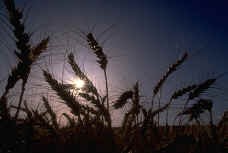 and with that I bid you good plantings. (2014 revise)
and with that I bid you good plantings. (2014 revise)

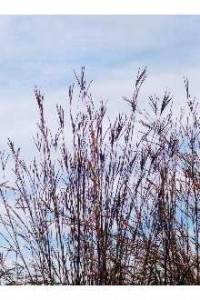
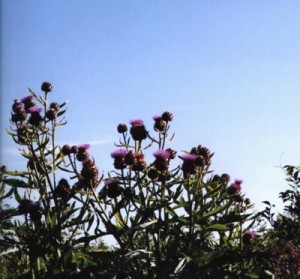
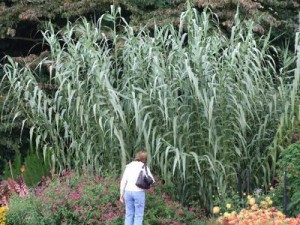
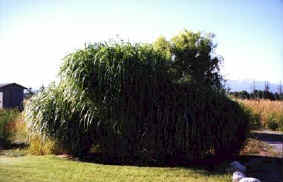
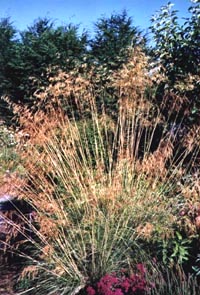
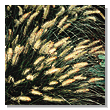
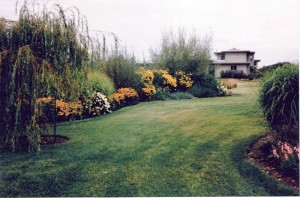
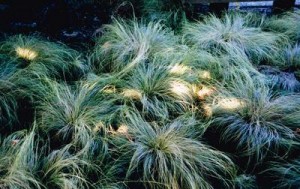
First off dear reader. This is not a message that should be private. If I make answers to something like this, I want it to be shared by all. Do the research esp. regarding the temperature factor.